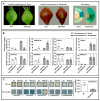PbMYB120 Negatively Regulates Anthocyanin Accumulation in Pear
- PMID: 32102306
- PMCID: PMC7073189
- DOI: 10.3390/ijms21041528
PbMYB120 Negatively Regulates Anthocyanin Accumulation in Pear
Abstract
Subgroup 4 R2R3 MYBs play vital roles in the regulation of anthocyanin biosynthesis. However, there is limited knowledge regarding the functions of MYB repressors in pear (Pyrus × bretschneideri). Here, PbMYB120 was identified as a potential regulator of anthocyanin biosynthesis. A phylogenetic analysis revealed that PbMYB120 was clustered into the FaMYB1-like clade of the subgroup 4 R2R3 MYBs. PbMYB120 was expressed higher in red peels than in green peels in five pear cultivars. PbMYB120 expression was positively correlated with anthocyanin accumulation. However, the transient overexpression of PbMYB120 led to the inhibition of anthocyanin accumulation and PbUFGT1 expression. Promoter binding and activation assays indicated that PbMYB120 binds to the promoter of PbUFGT1 and represses the promoter's activity. Thus, the inhibition of anthocyanin accumulation by PbMYB120 may be correlated with the repression of PbUFGT1. Furthermore, during anthocyanin induction, the expression levels of anthocyanin activators and PbMYB120 were upregulated. This study demonstrated that PbMYB120 was highly expressed in pear tissues having higher anthocyanin accumulations but acted as a repressor in the regulation of anthocyanin accumulation. PbMYB120 may work coordinately with anthocyanin activators and serve as a balancer of anthocyanin accumulation.
Keywords: PbMYB120; anthocyanin; pear; repressor; subgroup 4 MYBs.
Conflict of interest statement
The authors declare no conflict of interest.
Figures





References
-
- Dussi M.C., Sugar D., Wrolstad R.E. Characterizing and quantifying anthocyanins in red pears and the effect of light quality on fruit color. J. Am. Soc. Hortic. Sci. 1995;120:785–789. doi: 10.21273/JASHS.120.5.785. - DOI
MeSH terms
Substances
Grants and funding
LinkOut - more resources
Full Text Sources

